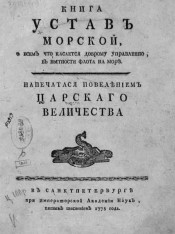
The Presidential Library’s materials illustrate the history of the emergence of the Naval Charter
Alexander III said that in the whole world Russia had only two faithful allies - its army and navy. And if the regular army in our state was formed around the 16th century under Ivan the Terrible, then our country owed the appearance of the “second ally” - the fleet - to Peter I. He also became the author of the first Russian Naval Charter, which was adopted on January 24, 1720. The Presidential Library’s portal features rare editions of the charter, with research materials that reveal the history, content and significance of this important document, and trace which documents preceded the appearance of the charter.
Interest in naval affairs arose from Peter I in 1688, when he, still a 16-year-old prince, found an old boat in the village of Izmailovo. Restoring it, Pyotr Alekseevich became interested in shipbuilding. It was no coincidence that this boat was later called the "grandfather of the Russian fleet".
Attempts to create a regular fleet were made back in the era of Alexei Mikhailovich. Then, in particular, the ship Oryol was built, on which a red-blue-white flag was placed. However, only Peter I began to consistently engage in the creation of the fleet. At the end of the 17th century, the first shipyard was set up in Voronezh, and the construction of the fleet began here.
During the Northern War, the center of shipbuilding moved to the northwestern part of the country. During the struggle for access to the Baltic Sea, under the leadership and with the personal participation of Peter I, a powerful flotilla was created in Russia in the shortest possible time, which allowed the country to acquire the status of a maritime power. By 1725, the Russian fleet had become one of the strongest in the Baltic.
Tsar Peter understood that the creation of a regular fleet was not only the construction of ships, the casting of cannons, the recruitment of sailors and the education of officers. This process required the creation of a legislative framework, without which neither the army nor the regular navy can exist.
Since our country did not have its own naval charter, Peter I began to study European documents. Among the sources to which the tsar turned was the Naval Charter of Louis XIV, similar English documents on naval affairs were translated for Peter. Peter I approached the matter thoroughly, accumulated experience.
Gradually, as needed, more and more new documents appeared, and finally, in 1720, the Naval Charter was published, which began to be developed back in 1715. It is interesting that by that time the Russian Baltic Fleet had already won the famous first naval victory in the history of Russia - on August 9, 1714 at Cape Gangut. This indicates, in particular, that the document was written with skill, based on accumulated experience.
Peter I was assisted in the preparation of the Charter by the son of his mentor Nikita Zotov, Captain Konon Nikitich Zotov, and the Tsar's associate Peter Shafirov. Nikolai Rogulin, Associate Professor of St Petersburg University, spoke about this and other circumstances of the creation of the document in the video lecture The Naval Regulations of Peter the Great and the Military Legislation of the Time of Peter the Great (as part of the project Video lecture of the Presidential Library Knowledge of Russia).
The charter begins with an appeal to the well-meaning reader, which was compiled by Feofan Prokopovich, the most prominent figure in the time of Peter the Great. This preface told about the history of Rus relations with the sea from the time of Rurik and further, up to the Northern War. The preface brings the reader to the idea of the need for a fleet for Russia.
The charter of Peter I consisted of five books. The first contained provisions on the highest commanding staff of the Navy.
The following charter books included decrees on the seniority of ranks, "about flags and pennants, about lanterns, about salutes and merchant flags".
The fourth book focuses on the rules of conduct on the ship, the number of officer servants according to ranks, the procedure for distributing provisions, methods for determining rewards for taking enemy ships, battle wounds and length of service. The fifth book About Fines was a naval judicial and disciplinary charter.
Peter I understood that without a moral core, which the Orthodox faith can be, no talk about discipline works.
Issues of social support for those injured in battle or those who have grown old were specifically discussed here. The widows and children of those who died in the service were entitled to part of the sailor's salary.
By royal decree, the Naval Charter was printed as a separate edition. The charter of Peter I became the most important legislative document of the Russian fleet. After revision, it was republished in 1724 and was valid until 1797 with minor changes. Then this Peter's Naval Charter was replaced by a new one, which took into account the change in ideas about the methods of warfare, however, many provisions of the later editions of the Naval Charter are based precisely on the principles laid down by Peter I.

